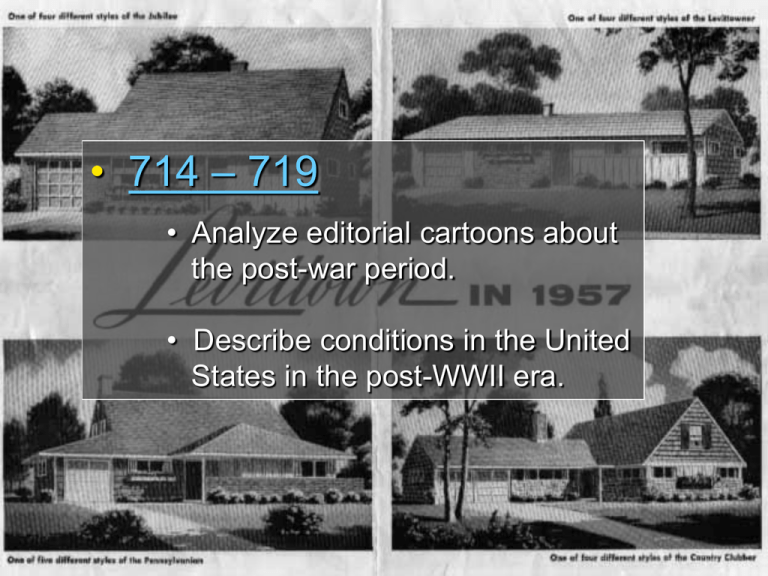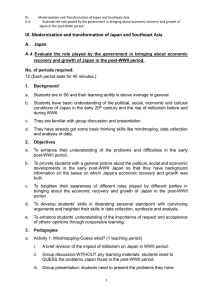Analyzing Political Cartoons
advertisement

• 714 – 719 • Analyze editorial cartoons about the post-war period. • Describe conditions in the United States in the post-WWII era. The Great Boom (Post-WWII) Analyzing Political Cartoons: – Time and place – Symbolism – Background knowledge – What does this cartoon suggest about the postwar world? - The use of atomic weapons might lead to an uncertain future… The Great Boom (Post-WWII) Directions: – Each group will have approximately 45-60 seconds to discuss and analyze the cartoon. • Write down and label your analysis in your notebook: – Cartoon # ___: – Meaning: (What Issue is described?)_______ – Symbolism: __(Explain 2 examples used)______ – Pass your group’s cartoon clockwise to your neighboring group. Mail man Mail man “I’m Mrs. Ed Barnes, where do I live?” The Great Boom (Post-WWII) Changes/Issues Facing Post-War America: • • • • • • • Shortages of everything from groceries to cars to housing which caused a fear of inflation in the economy. Concern over the developing Cold War due to the Soviet Union imposing Communist regimes in Europe while the U.S. protected democratic style governments. The U.S. began to act as international police officer as protector of democracies in the world rather than be isolationist. Cold war also created the need for defense spending which stimulated the economy. Left wing, radical ideas grew taboo and unacceptable as well due to the threat of the Cold War (Communism). Racial discrimination continued. Labor strikes erupted. Solutions: 1. Economic Policy: The Employment Act of 1946: • It defined economic growth and high employment as national goals. • Created the “Council of Economic Advisors” to assist the president. 2. The Taft-Hartley Act of 1947 to reduce strikes. - UMW John L. Lewis opposed it, Truman tried to veto it, but failed. - Attack by big business on unions: - blocked the “closed shop” - prevented boycotts - unions had to swear there were no communist members - “cooling off” period imposed before a union could strike Solutions: 3. The G.I. Bill • Serviceman’s Readjustment Act (1944) • Guaranteed Loans to veterans to purchase homes as part of the V.A. mortgage program. • Paid tuition, books, stipends for veterans to attend college. 4. Levittown - William Levitt built development in 1947 using “mass production” techniques which provided affordable, low cost housing. - Long Island, New York - Basic house was 800 sq. ft., two bedrooms, living room, bath and kitchen. (unfinished attic) Results of the Housing Boom? • Home ownership soared • Housing starts peaked at two million (1950) • By 1950, 55% of Americans owned a home • Problems • Isolated women and children in suburbs and African-Americans were excluded. • “redlining”- refusal of banks/insurance companies to give loans/insure properties in urban areas. • “white flight”- white collar workers leaving. Solutions: 5. Steps Towards Civil Rights • “Committee on Civil Rights” (1946) • The Justice Department began to support antisegregation lawsuits filed by the NAACP. • “Equality of Treatment” Order to military (1948) • The public began to support desegregation in professional sports. 1947 Report on Civil Rights Jesse Owen Joe Lewis Jackie Robinson 6. Consumer and Baby Boom • Marriage rates increased. • The “Baby Boom”. • Early 1940s = average 2.9 mil. births • Late 1940s = average 3.5 mil. births -Newspaper editorial -Magazine advertisement -Marquette High School policy/rule book The Great Boom (Post-WWII) Which do you think was the greatest problem and why? 1. Housing shortage and inflation. 2. Cold War and re-arming of weapons. 3. Racial discrimination 4. Labor union unrest/strikes






